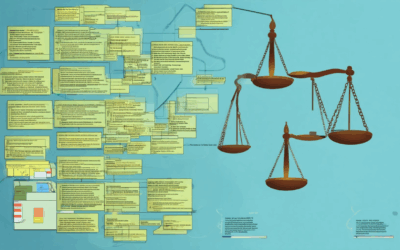Creating effective nonprofit policies and procedures is a cornerstone of successful organizational management. Whether your nonprofit is navigating its growth, ensuring compliance, or streamlining operations, having well-defined policies is essential. This comprehensive guide dives into the nonprofit policy creation process, offering a clear framework for developing strategies that align with your mission and maintain accountability. From understanding the flow of policy creation to exploring tools and resources, this guide covers everything you need to know to create robust policies that support your nonprofit’s goals. By following the steps outlined here, you’ll not only enhance your organization’s efficiency but also ensure long-term sustainability through proper implementation. Whether you’re new to nonprofit policy creation or looking to refine your existing processes, this guide serves as an invaluable resource for anyone tasked with shaping the future of your nonprofit.
Key Takeaways
- Bylaws are the cornerstone of nonprofit governance, establishing the organizational structure and decision-making processes.
- Policies provide operational guidance, offering ethical frameworks and addressing specific organizational challenges.
- Procedures offer detailed workflows, ensuring efficient execution of daily operations.
- Bylaws generally take precedence over policies, though policies may sometimes override if sufficiently specific.
- IRS doesn’t mandate bylaws for tax-exempt status but highlights their importance for legal compliance and effective governance.
- Document hierarchy begins with articles of incorporation, followed by bylaws, policies, and procedures.

How to Write Policies and Procedures for a Nonprofit
A well-written nonprofit policy manual is essential for maintaining organizational integrity, ensuring compliance, and streamlining operations. Below is a step-by-step guide to crafting effective policies and procedures for your nonprofit:
1. Define Your Mission and Values
Start by clearly articulating your nonprofit’s mission and core values. These serve as the foundation for all policies and procedures. Ensure everyone within the organization understands and aligns with these principles.
2. Establish Governance Policies
Outline the roles and responsibilities of your board of directors, officers, and employees. Include policies on:
- Board Composition: Requirements for board members, term limits, and selection process.
- Conflict of Interest: Procedures for reporting and addressing conflicts of interest.
- Meeting Policies: Rules for scheduling, attendance, and decision-making at board meetings.
3. Develop Financial Management Policies
Establish clear guidelines for handling finances. Include:
- Budgeting: Process for preparing annual budgets and tracking expenditures.
- Accounting: Requirements for recording and reporting financial transactions.
- Fundraising: Policies for accepting donations, grants, and other funding sources.
4. Create Human Resources Policies
Ensure fair treatment of employees and volunteers with policies covering:
- Recruitment: Process for hiring and onboarding staff and volunteers.
- Employee Conduct: Code of conduct and disciplinary procedures.
- Performance Evaluation: Guidelines for assessing employee performance.
5. Establish Fundraising and Donor Relations Policies
Develop procedures to ensure ethical and professional interactions with donors:
- Donation Processing: Steps for receiving and acknowledging contributions.
- Grants Management: Protocol for applying for and managing grants.
- Communication: Standards for donor communications and acknowledgments.
6. Include Compliance and Legal Considerations
Ensure all policies adhere to relevant laws and regulations. Include:
- Compliance Checklist: Summary of legal requirements for nonprofits.
- Liability Insurance: Requirements and coverage for protecting the organization.
- Intellectual Property: Policies on using logos, names, and other assets.
7. Implement Risk Management Strategies
Identify potential risks and establish mitigation strategies. Include:
- Risk Assessment: Process for identifying and evaluating risks.
- Contingency Plans: Procedures for responding to emergencies or crises.
- Insurance Coverage: Details on existing and recommended insurance policies.
8. Utilize Technology Effectively
Update your policies to reflect modern practices, such as:
- Cloud Solutions: Guidelines for using cloud-based tools for recordkeeping and collaboration.
- Data Security: Protocols for safeguarding sensitive information.
- Communication Channels: Policies for using social media and email marketing.
9. Monitor and Evaluate Policies
Regularly review and update your policies to ensure they remain relevant and effective. Include:
- Review Process: Schedule for updating policies and seeking stakeholder input.
- Evaluation Metrics: Criteria for measuring the effectiveness of policies.
- Implementation Tracking: Methods for monitoring policy adherence.
10. Communicate Policies Clearly
Ensure all staff, volunteers, and stakeholders understand and comply with policies through:
- Training Programs: Workshops and orientations on policy implementation.
- Policy Handbooks: Comprehensive resource for all employees and volunteers.
- Sign-off Proxies: Requirement for acknowledging receipt and agreement with policies.
By following these steps, your nonprofit can establish a robust framework for policies and procedures that support its mission and ensure long-term success. For further details on implementing these strategies, explore additional resources available on NPO Expert .
Example of a Nonprofit Financial Policy
A nonprofit financial policy is a set of guidelines established to ensure effective financial management, transparency, and accountability. Here are some examples of common nonprofit financial policies:
- Grant Management Policy: This policy outlines how grants are administered, including tracking fund usage, documenting expenditures, and reporting to donors as required by funding agreements. It may specify that all grant-related activities must be separated from general funds to maintain accountability.
- Expense Reimbursement Policy: This policy details the process for submitting and approving expenses, such as travel, mileage, or office supplies. It may state that all expenses must be accompanied by receipts and that certain types of expenses require prior approval, such as those involving board members or senior executives.
- Salary Review and Compensation Policy: This policy establishes guidelines for evaluating and setting salaries. It may include provisions for regular performance reviews, market-based adjustments, and exceptions for leadership roles. The policy might also specify that salary decisions align with the organization’s mission and financial capabilities.

What is the 501c3 Policy?
To understand the 501(c)(3) policy, it’s essential to grasp its significance in the realm of nonprofit organizations. This tax provision exempts qualifying organizations from federal income taxes, allowing them to focus on their mission-driven activities without the burden of paying corporate taxes.
Here’s a breakdown of the key aspects:
- Definition and Purpose :
- A 501(c)(3) organization is defined as a nonprofit entity that operates exclusively for religious, educational, scientific, literary, or charitable purposes, or fostering amateur sports, physical fitness, or neighborhood conservation.
- The primary purpose must be to benefit the public interest rather than private individuals or entities.
- Operational Requirements :
- The organization must operate for its stated exempt purpose(s) and not engage in activities that are unrelated to its mission.
- It must not allow any part of its net earnings to inure to the benefit of any private shareholder or individual.
- Exclusion of Private Inurement :
- No substantial amounts of the organization’s earnings may pass through to private individuals, such as officers, directors, or key employees, except reasonable compensation for services rendered.
- Excessive fringe benefits or excessive salaries can jeopardize the organization’s tax-exempt status.
- Compliance and Filing Requirements :
- Organizations must apply for recognition of tax-exempt status by filing Form 1023 with the IRS or obtaining a ruling letter if they qualify under a specific provision.
- Annual reporting and compliance with IRS regulations is mandatory to maintain tax-exempt status.
For further reading on managing nonprofit operations and staying compliant, visit NPO Expert to explore resources tailored for nonprofit leaders.

Understanding Bylaws, Policies, and Procedures in Nonprofits
Nonprofits operate through three primary documents: bylaws, policies, and procedures. While they may overlap in function, each plays a distinct role in governing and operating the organization effectively.
Bylaws
Bylaws are the foundation of a nonprofit’s governance structure. They establish the rules for how the organization will be managed, including:
- Membership eligibility and rights
- Board composition and election processes
- Meeting procedures and voting rules
- Amendment processes for bylaws themselves
Bylaws are typically more formal and legally binding, outlining the organizational structure and decision-making authority. They define roles and responsibilities at all levels of the organization, ensuring consistency and compliance with legal requirements.
Policies
Policies are supplementary guidelines that provide direction on specific operational areas. They are less rigid than bylaws but offer detailed frameworks for addressing particular organizational challenges. Common types of policies include:
- Conflict of Interest Policy
- Donation Acceptance and Gift Acceptance Policy
- Whistleblower Policy
- Travel and Expense Policy
Policies are designed to ensure ethical practices, compliance with laws, and consistent operations. They may be updated regularly to reflect changing regulations or organizational needs.
Procedures
Procedures are the step-by-step instructions for carrying out specific tasks or functions within the organization. They detail how operations like:
- Processing Donations
- Conducting Board Meetings
- Overseeing Fundraising Activities
- Handling Member Resignations
Procedures are highly detailed and focused on the mechanics of daily operations, ensuring that everyone involved understands the expected workflows and protocols.
Key Differences
While bylaws, policies, and procedures all play critical roles, they differ in scope and flexibility:
- Bylaws : Provide the overarching governance structure and are legally enforceable.
- Policies : Offer guidance on specific operational areas and are more adaptable over time.
- Procedures : Detail the specific steps for executing tasks and are highly implementation-focused.
Together, these documents ensure that a nonprofit operates smoothly, ethically, and in compliance with legal and regulatory requirements. Regular reviews and updates to each are essential to maintain effectiveness and alignment with organizational goals.
Do bylaws supersede policies?
Bylaws do not automatically supersede policies. While they establish the foundation for organizational governance, their authority depends on several factors, including the organization’s legal structure, governing documents, and operational needs.
The relationship between bylaws and policies can be complex. Generally, bylaws are considered the highest authority when they conflict with policies, but this is not always the case. The precedence often depends on:
- Legal Requirements: Laws and regulations may take priority over both bylaws and policies.
- Organizational Structure: Larger organizations may have a hierarchy where bylaws govern overarching principles, while policies address specific operations.
- Specific Provisions: Policies may be more detailed than bylaws, leading to situations where policies take precedence in practice.
To understand this better, consider the typical hierarchy of organizational documents:
Hierarchy of Documents
1. Articles of Incorporation (or similar formation documents)
2. Bylaws
3. Policies
4. Procedures and Operational Guidelines
In many cases, policies are developed to align with bylaws, but they can also address specific operational details. For example, a policy might detail a particular procedure that aligns with a bylaw, but if a policy directly conflicts with a bylaw, the bylaw typically takes precedence. However, this is not universal, and the relationship may vary depending on the organization’s governance structure.
For nonprofits and other organizations, consulting with legal counsel or governance experts is recommended to ensure compliance with state laws and organizational bylaws. At NPO Expert, we provide resources to help you navigate these complexities, ensuring your organization operates smoothly while adhering to legal and regulatory standards.
Want to learn more about how policies and bylaws interact? Explore our governance resources to better understand the nuances of organizational documentation.

Does the IRS Require Bylaws for Nonprofits?
The IRS does not specifically require bylaws for nonprofits to obtain tax-exempt status under Section 501(c)(3). However, having bylaws is highly recommended for clarity in governance and legal compliance. Here’s a breakdown:
- IRS Requirements : The IRS focuses on the organization’s activities and financials rather than internal governance. Bylaws are not mandatory for tax-exemption but are useful for defining operational procedures.
- State Laws : Many states require bylaws for incorporation, which is a separate requirement from IRS tax-exemption. These bylaws outline organizational structure and decision-making processes.
- Recommendations : While not legally required by the IRS, bylaws are essential for effective governance. They help prevent conflicts and ensure smooth operations, demonstrating accountability to stakeholders.
- Filing : Adopting bylaws early is advisable. If included in the 501(c)(3) application, they should be submitted with the IRS forms, though this is not a strict requirement.
In conclusion, while the IRS does not mandate bylaws, they are crucial for organizational clarity and legal protection.





0 Comments